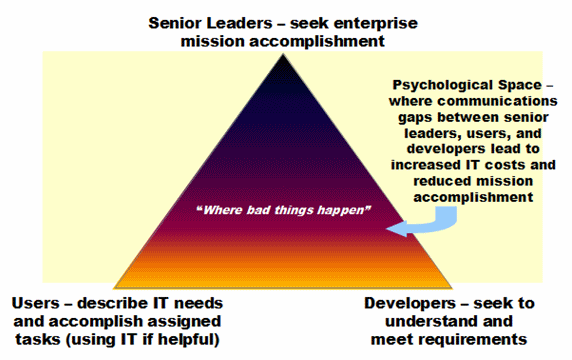E-MAPS Problem Space
| For senior leaders, information technology (IT) is not about software, hardware, and other
products but about facilitating mission accomplishment and enabling
organizational efficiency and operational effectiveness. E-MAPS
provides services for this problem space. (1) Senior leaders, (2) IT users who execute the tasks directed by senior leaders, and (3) developers of IT are mutually dependent. |  |
• Senior leaders succeed only if users of IT accomplish their assigned tasks.
• Users cannot succeed unless the developers provide good IT.
• Developers cannot succeed unless they get (1) good requirements from the users and senior leaders and (2) can verify their work with users and senior leaders as the IT is developed.
• Users need documents and instruction on how the IT works and how to use the IT to accomplish standard tasks.
• Users cannot succeed unless the developers provide good IT.
• Developers cannot succeed unless they get (1) good requirements from the users and senior leaders and (2) can verify their work with users and senior leaders as the IT is developed.
• Users need documents and instruction on how the IT works and how to use the IT to accomplish standard tasks.
The diagram above represents the reality that the challenge is not to build
or buy IT in isolation but to bridge the gaps between senior leaders,
users, and developers so that the right IT is developed with the right
capabilities and then applied effectively, in part because of good
references and instruction. E-MAPS services facilitate closing
the gaps between senior leaders, users, and developers.
Interoperability is organizations working together towards common ends (i.e., unity of
effort). Interoperability in the sense of communicating data
and information machine-to-machine is important, but the value of such
sharing is determined by what the users of the IT accomplish using the
data and information shared machine-to-machine.
• Information-Based Interoperability
• Information-Based Interoperability
Efficiency and Effectiveness
Senior
leaders fund IT to advance mission accomplishment and improve their
enterprises’ efficiency and effectiveness. Gaps between
domains, organizations, and IT systems limit efficiency and
effectiveness. Often, these gaps deprive senior leaders of the
information they need for good decisions that lead to efficiency and
effectiveness. Efficiency and effectiveness therefore requires
closing gaps between domains, organizations, and IT systems with
communities of interest (COI), standardized vocabularies, doctrinal
publications, and ontologies.
Data,
information, and IT require user education. We accept the need to
educate users of weapons, automobiles and airplanes because of the
needless and accidental damage inflicted by untrained users of these
tools. The accidental and tragic 1999 bombing of the Chinese
embassy in Belgrade is an example of very serious damage inflicted
because of data analyzed and produced by an untrained individual.
Today, probably as a result of the bombing, the Chairman of the Joint
Chiefs of Staff Instruction 3505.01A, “Target Coordinate
Mensuration Certification and Program Accreditation” requires
individuals who produce target data by mensuration to be well trained
and certified. While such warfighting training is critical, it is
impractical to require the same high level of training for all
producers of data and information and for developers of sensors and
other IT tools that produce data automatically. But it is as important
to provide an appropriate level of training on the production of data
and information as it is to provide training on the basics of cyber
security. For over 15 years, E-MAPS has been identifying and
documenting the basics of data and information production.
Ontology is the science of representing reality consistently across domains,
organizations, and IT systems. Everyone performs ontology as they
make sense of their circumstances and plan their future actions.
The concepts and methods of ontology are to the development and use of
IT as weather is to development and use of aircraft and ships.
Yet, while there are first-rate, readily available references for
pilots and seaman on weather, easy-to-access and easy-to-use references on ontology
are not available to IT developers and users. E-MAPS and its
partners provide such references and instruction.
• Basic Value of Ontology (Ontology for the Above Average Manager)
• Warfighters, Ontology, and Stovepiped Data, Information, and Information Technology)
• Basic Value of Ontology (Ontology for the Above Average Manager)
• Warfighters, Ontology, and Stovepiped Data, Information, and Information Technology)
The
term Big Data represents the reality that advances in (1) sensors and
other computer-based data-generating tools and (2) computer networks
force far more data on users of IT than they can comprehend or even
sort out without using IT tools. Big Data conversations and tools
tend to focus on manipulating semi-structured or unstructured
data. Manipulation is important, but it is more important to
start by identifying the information problem to be solved and the
ontology (i.e., representation of reality) that describes a
problem’s domain. E-MAPS and its partners provide support
in representing domains.
• Enabling Big Data Solutions
• Enabling Big Data Solutions